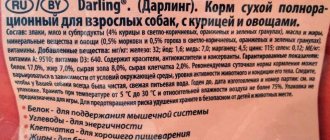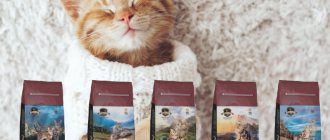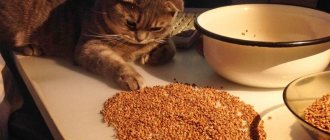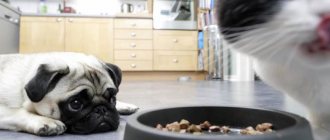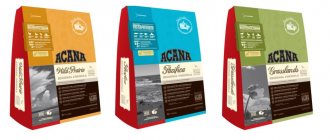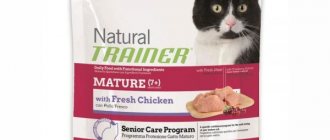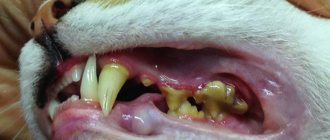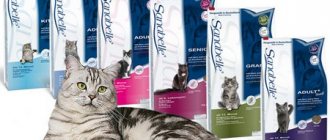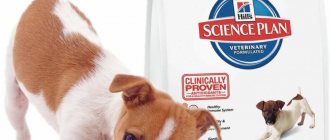History of appearance
The first dry food appeared in England 150 years ago. Biscuits for dogs were invented by James Spratt in 1861. It looked like a bone, and the composition included flour, vegetables, blood and minced meat. The food released for sale was initially perceived only as a delicacy and was available only to wealthy dog breeders. The popularity of the new food came a decade later, when the meat dog biscuit was replaced by a milk biscuit. The food actually contained milk and was advertised as a healthy treat for your pet's dental health.
In 1922, the Purina company, one of the largest manufacturers of dry food of our time, bought all the rights and put the production of dog biscuits on stream. And a little later she founded a research center dealing with nutrition and diet planning, which all major manufacturers have today. Before the outbreak of World War II, the US economy was experiencing difficulties and therefore low-cost food began to appear on sale. They used grains as a source of energy. Since then, there has been a misconception about the dangers of dry food for pets.
Is it possible and how to rinse a dog’s nose at home?
In the middle of the 20th century, dry food finally conquered the market, showing that they were more convenient and easier to feed pets. At this time, new manufacturers and brands begin to appear, and food is produced from food waste that cannot be used for human nutrition. The next step was the appearance of the first complete food, the purpose of which was to completely replace natural nutrition. It was distinguished by a completely balanced composition and ease of use. In addition, it was cheaper compared to natural food.
Further, in the 70s, food for pets with health problems began to appear. Moreover, they were actively prescribed by veterinarian prescription. In the 80s, manufacturers became seriously concerned about their quality. This is how super-premium food appeared, which was more meat-containing. In addition, vitamins and minerals were added to feed for the first time.
In Russia, the first dry dog food began to appear in the early 1990s. At first these were foreign brands, but soon Russian manufacturers began to appear. Modern manufacturers are not limited to producing only dry food. On sale you can find canned food, artificial bones for chewing, cookies and biscuits belonging to different classes.
Dry food Acana
Rating of the best canned food
Perhaps the most important criterion by which canned cat food is distinguished is the class that determines the quality and, accordingly, the price category of the product.
There are 4 classes of cat food (arranged in ascending order):
- Economy
- Premium
- Super premium.
- Holistic.
Let's look at the main characteristics of all classes and name the leaders within each of them, based on reviews of cat owners at the beginning of 2020.
Economy class
In addition to low cost and low quality, the peculiarity of this category of food is that it is they that are the subject of the most widespread advertising, often intrusive and very rarely conscientious.
Did you know? In 1999, Australian football star Harry Hawking temporarily changed his last name to
"
Whiskas
"
.
These were the terms of the agreement concluded between the football club and the sponsor - the manufacturer of the world famous economy class cat food. As a result, the club earned 50 thousand dollars. When the contract expired, Whiskas became Hawking again and now coaches his favorite club under his old name. In addition to Whiskas, in the economy class of canned cat food you should pay attention to such brands as:
- Darling (food from the famous American): has a pleasant smell and, according to the manufacturer, contains Omega-3 polyunsaturated fatty acids that are beneficial for wool, is available in a wide range, and is inexpensive.
- Felix (also a Purina product): good in its class, often recommended by veterinarians for owners who cannot afford more expensive foods.
- Our brand (Russia): a wide selection of feeds of different textures and compositions, the ability to choose packaging that suits the size, low cost.
- All Cats (Denmark): convenient packaging, low price, contains Omega-3 and Omega-6.
- Vaska (Russia): comes in tin cans and is inexpensive.
When making a rating of economy-class food, you should always keep in mind that the advantages of such products are very conditional: a low price, by definition, cannot ensure high quality.
Economy class food also includes “Kitiket”.
There is almost no high-quality meat in this category of food, but there are bones and offal in large quantities, as well as thickeners, preservatives, flavor enhancers and other chemicals. All this not only harms your pet’s health, but also makes him addictive.
Premium class
These foods, unlike products of the previous category, should already contain meat, although its share in the product rarely exceeds 20%. Let's face it, the line between an economical and a premium option can be very arbitrary, and yet this is already something.
Premium-class feeds include such as “Purina Van”, “Probalance”.
In addition, manufacturers of cheap canned food often do not bother themselves with a detailed description of the composition of their products, while when buying premium food, you can already count on reading on the packaging what exactly it is made of.
Cat owners have given good reviews to the following foods of this class:
- Pro Plan (products from Purina): balanced composition, wide range, including medicinal foods, the presence of natural meat. Among the disadvantages are the high content of vegetable protein, liver that is unsafe for cats and some “animal fat”, the origin of which the manufacturer does not specify.
- Royal Canin (French food, produced, among other things, in Russia): a very wide range, high quality (this food is often classified as super premium, but most owners agree that it still does not reach this category). Disadvantages: relatively high price, ingredients are not clearly indicated.
- Happy Cat (made in Germany): wide selection, very good consumer reviews (cats eat food with great pleasure, look great and remain highly active). The main disadvantage is the lack of wide access and the need to order from online stores.
- Organix (Holland, produced in Russia): low price with good quality, many additional additives that improve the composition, no unnecessary chemical components. Disadvantages include the lack of single-use packaging (available in cans with a minimum portion of 100 g), poor quality packaging (the “easy open” ring often remains in your hands), and too much salt.
- Hill's (USA, Holland): very wide selection, high quality (as in the case of Royal Canin, the food, according to the distributors, belongs to the super premium class, but is slightly lower in quality). Disadvantages also include the lack of a detailed description of the composition and the high amount of carbohydrates.
Super premium class
The main thing that distinguishes super premium canned food from cheaper analogues is the absence of dangerous chemical additives. Everything here should be natural: meat, offal, grains, vegetables. In addition, the concept of “meat” in the composition always has a definition.
Super-premium food includes such as “Fest Choice”, “Monge”.
The rating of canned cat food in this category looks like this:
- Optimeal (Ukrainian production according to the Swiss formula): excellent price/quality ratio, convenient packaging, promotional release forms (3+1 - four bags for the price of three). The disadvantage is that it is not always on sale.
- Brit Care (Czech Republic): good price/quality ratio, hypoallergenic, high meat content. The main drawback is that these products are not available for sale in all stores.
- Leonardo (made in Germany): very high quality, natural meat content of at least 65%, in addition, the composition contains minerals necessary for the normal development of the cat. Chemical impurities are minimal. Among the shortcomings is the lack of certain vitamins responsible for the condition of the coat and skin.
- Gourmet Gold (products from Purina): very diverse selection, high quality, natural ingredients. Among the shortcomings is the lack of a ruler for kittens, short shelf life (days after opening). However, a smart consumer understands that the latter is actually an advantage of the food, since it indicates a small amount of preservatives.
- Bozita (Sweden): strict quality control, high meat content, the presence of additional components that strengthen the immune system. The main disadvantage is the high price.
Holistic class
Holistic is what can be called “the best of the best.”
Important! Holistics (from the Greek “ὅλον”, holon is a philosophical category denoting something that is both part and whole) is a special category of new generation food. Their main feature is the perfect balance of taste and nutritional properties with the highest quality. Such food is intended for animals, but can also be consumed by their owners!
For an ordinary cat owner, it is not at all necessary to purchase food of this class, because with such requirements, the price of this kind of product is not just high, but often simply exorbitant. But those who keep expensive exhibition animals can afford such expenses (as they say, the situation obliges).
In such feeds:
- the meat content is at least 70%, and we are talking only about meat ingredients of selected quality;
- no by-products (especially cartilage and bones);
- contains natural plant components (fruits, vegetables, herbs);
- no grains or their content is minimal;
- no vegetable oils or soy;
- Only natural ingredients are used as preservatives - ascorbic acid, vitamin E, rosemary.
Holistic foods also include such foods as Orijen and Bosch Sanabel.
In the ranking of elite canned cat food we name the following brands:
- Applaws (Britain): wide range, various shapes and textures, specialized food for kittens and sterilized cats, various packaging options.
- Almo Nature (Italy): these products were the first in the holistic class. It is distinguished by a variety of tastes and the presence of special foods (in particular, for the prevention of urolithiasis).
- Asana (Germany): in addition to high quality, it is worth noting a detailed description of the product’s composition on the packaging, as well as the availability of the product in many stores. The disadvantage is the high price, even for a holistic practitioner.
- Canidae (USA): balanced composition, natural ingredients, Omega-6 and Omega-3, as well as probiotics. Disadvantage: it is not sufficiently represented on the Russian and Ukrainian markets.
- (Canada): very economical (to obtain the required amount of nutrients, the animal only needs to eat much less of these canned foods compared to analogues from other manufacturers), balanced composition, wide range of flavors, rave reviews from veterinarians. Among the disadvantages, in addition to the high price and low availability, is also the high ash content.
For kittens
A kitten’s digestion has not yet been formed, and therefore special requirements must be placed on the quality of food for the smallest animals. In addition to the delicate texture (small pieces, pates and mousses), it is also important that the fat content of the food is no more than 20% and protein no more than 35%.
Of course, kitten food is available in all classes of canned food, but you still shouldn’t choose the most economical option.
Important! For kittens, you should use food of at least premium class.
In terms of the ratio of affordable price and high quality, the rating of canned food for kittens is as follows:
- Optimeal (low price with high quality).
- Royal Canin (good digestibility, optimal composition).
- ProPlan (high meat content, absence of harmful substances, but higher price).
- Нills (wide selection, different shapes, affordable price).
- Happy Cat (affordable price, balanced composition).
A properly selected diet for a cat is the key to its health and longevity. The more thoroughbred the animal, the higher the requirements for the quality of its nutrition.
But even owners of “common yard” cats should not buy cheap canned food of dubious quality for their pets, especially since, after spending a little time, you can find relatively good food among economy-class products.
Classes
Depending on the composition and nutritional value, feed can be divided into classes. Before introducing them into your pet's diet, you should know the differences between them.
Economy
It contains feed of the lowest quality. The composition is dominated by waste and grains, and practically does not contain vitamins. Examples of such food include the brands “Pedigree”, “Chappi”, “Trapeza”, “Oscar”, etc.
If they are used for nutrition, you should take care of vitamin and mineral supplements, because economy-class food does not cover the dog’s daily needs. Their cost is usually just over 100 rubles per kg.
For hunting dogs, such as the Two-Nosed Dog, such food is strictly prohibited, as their keen sense of smell, which is so necessary for hunting, will be affected.
Premium
The ingredients for this class of feed are offal and chicken meat, and the source of carbohydrates is corn and wheat. Much less often they contain barley, rice and oats. In addition, the content of vitamins and minerals in these feeds is at a fairly high level. The most famous brand of premium food in Russia is Royal Canin.” They also include: “Arden Grange”, “Grandin”, “Unica Natura”, “4 Paws Club”, etc. 3 kg of such food can cost from 700 to 1600 rubles.
Super premium
This class includes high quality feed. For their production, natural meat and fish of several types, as well as offal (liver, heart) are used. The composition should not contain corn and wheat, and the source of carbohydrates most often are rice and potatoes (less often oats, peas, barley). In addition, the origin of preservatives and antioxidants - synthetic or natural - must be indicated on the packaging. If this information is missing, the food does not correspond to the declared class or is counterfeit. The best super-premium brands include Karmy, Ontario, Brooksfield and Savarra. The price of these feeds can range from 600 to 1900 rubles per 2 kg.
Holistic
It is produced only from the highest quality products and differs from other feeds in its high nutritional value. Its composition is dominated by natural vegetables, meat and fish and is free of proteins and glutens of synthetic origin. Sources of carbohydrates include lentils, rice and potatoes.
In terms of the content of vitamins and minerals, this class is significantly superior to others and completely meets the daily nutritional needs of the dog’s body. Most often, holistic food is used in the diet of show champions, pregnant and lactating bitches, as well as in the postoperative period. Foods in this class include: “NOW FRESH”, “Belcando”, “GO! NATURAL Holistik", "Hills Ideal Balance", "Acana". The price for them starts from 1000 rubles.
If it is expected that your pet's diet will consist only of dry food, it is advisable to use premium or higher brands.
The constant use of cheap food in the future threatens the dog with serious digestive problems. In addition, the higher the calorie content, the more nutritious the food, which means much less of it will be needed.
Dry food Purina
General information about feed
Industrial cat food is becoming increasingly popular and there are many reasons for this. The food does not need to be prepared, just pour it into a bowl - it’s convenient and saves time. Good food contains an optimal balance of nutrients, vitamins and microelements. Composing a complete diet, especially for a picky pet, is a difficult task, but food solves this problem.
Many owners find the convenience of storage a plus, because natural products quickly deteriorate, and drying, subject to certain conditions, can be purchased several months in advance. Only dry food is suitable for using an automatic feeder, since natural food should only be served fresh and warm.
Where there are pros, there are also cons. Feed is usually divided into classes:
- Economy is a useless or even harmful product for cats. The basis for this food is beans or soybeans, and the meat is the remains of carcasses - hooves, bones, skin, fat. There is no talk about vitamins and microelements. Economy food is a useless stomach filler that the cat will not benefit from.
- Premium and super-premium are everyday foods, which, logically, should be fully balanced and fortified. By the way, not every food of these classes meets the declared characteristics, but we’ll talk about this below.
- Holistic is the highest class of food, as close as possible to the natural composition. Manufacturers guarantee that the ingredients of holistic food are grown in the best conditions and do not contain additives, hormones, antibiotics, dyes, flavor enhancers and preservatives.
- Medicinal – food for animals with chronic health problems. It is important to understand that medicated food cannot be given to a cat for prevention, since it will most likely cause her to get sick.
Further, feeds differ in consistency:
- Dry or dry food - compressed granules with a minimum amount of water. Once in the stomach, the granules absorb a lot of liquid, so it is important to ensure that the cat always has water.
- Semi-moist food or kibbles with gravy are a more appetizing looking and smelling treat. Semi-moist food has a short shelf life.
- Pate is the same semi-moist food, but highly crushed. Feeding pate is not relevant unless we are talking about a kitten and the cat has healthy teeth. It is important to understand that the teeth will remain healthy as long as the cat uses them, that is, chews food.
- Treats – vitamins, hygiene sticks and dried meat. These products are used for rewards, disease prevention and dental problems.
The choice is rich and it’s difficult not to get lost in it. An unambiguous recommendation is only one natural one is better than economy feed. It is worth understanding that you will not be able to save money by putting your pet on cheap food; more precisely, your savings will quickly turn into substantial bills for your pet’s treatment. Natural feeding of a cat is not as complicated a science as it seems. Yes, there are nuances, it takes time, knowledge... but aren’t these sacrifices worth the health and longevity of the pet?
Always read the fine print, even when choosing food. Do not trust advertising and labels placed on food. You'll always see a happy cat and bright letters on the front of the package, but you should be interested in what's written on the back.
The composition should be understandable to a “mere mortal”. All ingredients must be clearly stated, for example, veal, not a mixture of meat. The composition is always compiled in descending order, that is, meat should come first on the list, not grains or vegetables. The composition must contain the full range of additives and preservatives. Please note that products with a long shelf life may not contain preservatives.
The next important point is the integrity of the pack. Refrain from purchasing food in bulk or make sure you are dealing with a reputable seller. Once opened, dry food oxidizes within a few months, making it useless and even harmful to the cat. To sell leftovers, dishonest sellers often mix stale or expired food with granules from a fresh bag. Please note that when sold by weight, feed should be stored in closed food-grade plastic containers and not in bags.
The popularity of industrial cat food is understandable - owners have no time to prepare food for their pets. Ready-made food can be placed in a bowl and stored for a long time - this is undoubtedly convenient. Striving for convenience, do not forget about the needs of the cat, because its health depends on a balanced diet!
We suggest you familiarize yourself with: Breeds of chickens colored broiler chickens
You should not feed your pet with economy class food. These products are made from cereals and do not contain meat or vitamins. Simply put, cheap food is a useless filler for the stomach. In addition, economy class products contain salts and preservatives, which contribute to the development of urolithiasis.
Premium and super-premium classes are considered optimal for everyday feeding. However, you should not blindly trust the inscriptions on the packs! Read the composition of the product, only it will show the true value of the food. Some manufacturers believe that food containing 70% grains is healthy, but this is far from true. Holistic class foods are considered the most natural, but they also have the highest price.
Package
The nutritional value of food depends not only on the composition, but also on storage conditions. There are a number of requirements for modern dog food packaging:
- tightness;
- opacity;
- moisture resistance;
- strength.
Their implementation ensures the safety of products and guarantees successful transportation.
Multilayer paper bags were used to package the very first food. Then the fashion for them disappeared, but today it is coming back again. This type of packaging has many disadvantages. Among them are fragility and leakage. In modern production, paper is used that is laminated or impregnated with special compounds that increase its strength.
Polyethylene packaging has low strength and transmits UV rays. It is rarely used, mainly for packaging feed over 15 kg. The most reliable packaging today is made from combined materials. Most often it consists of two layers: an inner one made of foil and an outer one made of polyethylene. The disadvantage of such packaging is the high cost of production.
Organization of feeding
Most breeds are prone to obesity, such as the Medium German Spitz or the Pomeranian, so when creating a diet you need to find the best option. The pet should not starve, but also not overeat. The diet depends on the physiology and age of the dog. The type of food does not play any role.
Until 2 months of age, the feeding frequency is approximately 6-7 times a day. Then the puppy is transferred to 5 meals a day, and from six months - to 3 meals a day. A young dog can be fed twice a day only after reaching one year of age.
The daily intake depends on weight and intensity of daily physical activity. The information on the packaging will help you calculate the required amount of dry food. Most often, the manufacturer indicates in the form of a table the recommended daily intake and number of feedings.
Table of norms per day and dosage by weight
| Dog weight (kg) | Daily value (g/day) | ||
| Low activity (1-2 hours per day) | Average activity (3-5 hours per day) | High activity (more than 5 hours a day) | |
| 2-5 | 45-90 | 55-110 | 75-145 |
| 5-10 | 90-155 | 110-205 | 145-245 |
| 10-15 | 155-210 | 205-245 | 245-330 |
| 15-20 | 210-260 | 245-300 | 330-410 |
| 20-25 | 260-310 | 300-355 | 410-490 |
| 25-30 | 310-350 | 355-410 | 490-555 |
| 30-40 | 350-440 | 410-510 | 555-690 |
| 40-50 | 440-520 | 510-600 | 690-820 |
| 50-60 and > | 520-595 | 600-690 | 820-935 |
Pregnant bitches are recommended to increase the daily intake by 20-50%, and nursing mothers are allowed to eat without restriction, leaving food in an accessible place. But for older dogs and those who suffer from obesity, on the contrary, the number of feedings is left the same, but the norms are reduced.
It's easy to find out if your pet is getting enough food. A well-fed dog reacts calmly when the bowl is removed, and after feeding, most often goes to bed. Constant overfeeding negatively affects the state of the digestive system and leads to unstable stools. In turn, insufficient nutrition leads to the fact that the pet becomes nervous, irritable, and begins to chew everything that comes in its way. At a young age, such dogs lag behind their peers in development; they have a poorly formed skeleton and insufficient muscle mass. They are easily recognized by their protruding ribs or sunken belly.
An automatic dog feeder will be very helpful in complying with feeding rules and regulations. It accurately measures the required dose of food and delivers it strictly at the programmed time. It is also recommended to add an automatic waterer to the kit, which will provide your pet with clean, filtered water enriched with oxygen.
A properly selected bowl is the key to good nutrition for your pet.
How to choose the right bowl
The dishes your pet will eat from are no less important. When choosing it, you need to consider several factors:
- material for manufacturing;
- height and size of the dog;
- wool thickness;
- muzzle shape.
In addition, it must be completely safe, that is, not have chipped edges or cracks. This is why it is not recommended to use old human dishes for feeding, as the dog may injure its tongue or cheeks while eating. Also, when choosing a bowl, you should consider its ease of use.
Bowls on a tripod are considered the most convenient. Most often they are made of steel, and adjustable tripod height makes it possible to use them for dogs of different sizes and ages. Bowls on stands are suitable for dogs with thick and long coats, such as Japanese Spitz, Kleinspitz, Keeshond or Eurasier and other Spitz, however, when purchasing, you should correctly calculate the height.
Ceramic is considered the safest material for making dishes for pets. Bowls made from it are comfortable and stable due to rubberized inserts, but are short-lived due to the fragility of the material.
Plastic bowls are environmentally friendly, but inconvenient to use. They are too light and quickly become unusable. Metal bowls are more stable due to their wide base. In addition, they are equipped with rubberized feet, which prevents them from sliding on the floor. Such bowls can last a very long time, but over time they also corrode.
How to feed correctly when switching your pet to dry food
Feeding dogs dry food is simple and profitable. This diet has many positive aspects both for the animal and for the owner. For the pet owner, this saves precious time, which can be spent productively instead of standing in the kitchen at the stove every day. Industrial feed has a long shelf life, so you don’t have to go shopping often; you can buy in bulk. For a dog, the benefit is in balance; you just need to give high-quality food from trusted manufacturers. At the same time, the dog will not be poisoned by unwanted foods, such as sausages, sweets, mushrooms and much more. Each method of eating food, both dry and natural, has its pros and cons, so the owner must find the right solution that suits his particular case.
General recommendations for feeding a puppy dry food
There are only two correct options for feeding pets: either dry food or natural products. Although almost every dog owner asks the question: is it possible to feed the dog dry and natural food at the same time? There are no few reasons why the answer is negative.
If you have definitely decided that cooking for an animal is not for you, then before going to the pet store and buying dry complementary food, you should arm yourself with enough information on this issue. Carefully consider the following tips for eating dry kibble properly.
How to accustom your pet to dry food
In principle, we have already discussed this point in detail above, but let’s repeat it again. The main thing here is to take your time. The puppy's stomach needs to get used to the new food. First to the soaked ones, then to the hard granules. The duration of the transition to drying is no more than three weeks. It all depends on the character of the pet. Some picky babies may refuse new food offered. Don't despair, continue to gradually increase the percentage of soaked granules. Once the animal gets used to them, it will also get used to the hard ones. And of course, monitor the condition of the baby; if something is wrong in his behavior, it is better to seek help from a veterinarian.
Transferring a pet from one type of food to another
This situation can arise if the dog has developed an allergic reaction to the food consumed. In this case, the puppy is switched to professional premium food. Just don’t make any sudden movements; we’ll do everything gradually again.
If the four-legged friend ate only wet food or canned food, then drying is also introduced in small dosages. But there is one rule. Canned food and hard granules should be given at different times. For example, in the morning for the first meal, wet food, in the afternoon for the second meal, dry granules. This must be observed, since digestion of a given food takes a different amount of time.
Transferring your pet from food to natural food
Yes, it also happens that the owner has a lot of free time, and he decided to switch the pet to a natural menu. In this case, everything is also done gradually to avoid diarrhea or constipation. They begin to give a little natural food at different meals. Find out what you can feed your puppy? How many times should you feed your puppy?
But before you pull a defenseless animal, you should think carefully about whether you need it. After all, it is not easy to feed a balanced diet of natural products for the proper development of a puppy. It will take a lot of time and every day. You will have to be well versed in such questions as: Can dogs have cheese?
Can dogs have sweets? Can dogs have bananas?
What can and cannot be combined with
Modern industrial food already contains substances necessary for a dog’s growing body, so there is nothing to worry about if the diet consists only of dry food. However, sometimes she needs to be pampered with small portions of treats. Starting at 4 months of age, you can give a piece of apple, carrot or cheese as a reward for following commands.
Also, pet stores sell special treats. Most often these are dried offal, trimmed meat and sausages. It is advisable to give them to the dog no more than 2 times a week, 100-200 grams.
Under no circumstances should dog biscuits be combined with meat or milk. An excess of proteins threatens your pet with serious problems with digestion, hair loss and dullness. Mushrooms, sweets, baked goods made from yeast dough, pickled and smoked foods are also dangerous for dogs. Chocolate is considered the most dangerous. A small piece of this human delicacy can cause serious poisoning to a pet.
The need for vitamins
Feeding your pet with dry complete food assumes that it contains all the necessary vitamins and minerals. Therefore, the risk of vitamin deficiency with such a diet is reduced to zero. Additives need to be taken care of when using economy class food. In this case, you can add multivitamins sold in pet stores or specialty pharmacies.
It is important not to overdo it with additives. An excess of any substance in the body can cause hypervitaminosis and even cause death.
Puppies have an excellent appetite
Peculiarities
In some cases, the owner wants to develop his own nutritional formula for the pet. However, do not forget that manufacturers indicate average values. For a particular dog, it is better to organize feeding according to individual standards.
Often, representatives of the same age have different nutritional needs. In addition, you should take into account the conditions of detention, daily routine, and the number of walks.
Puppies
When feeding a small pet, its exact age must be taken into account. It is especially important to contain the required amount of vitamins in the food for the full growth and development of the baby.
Large breeds
Large breed dogs, such as the Black Russian Terrier or Caucasian Shepherd, are prone to obesity, which often leads to heart disease. When choosing food for them, you should pay attention not to the energy value of the feed, but to the quality of the proteins. The high content of vitamins and minerals is especially important.
Small
Small dogs require a higher calorie diet. Breeds such as the Italian Bolognese, Bedlington Terrier, and Prague Ratdog are more active, which means they spend a lot of energy that needs to be replenished.
Dry and natural - what's the difference?
If by natural feeding we mean preparing food for an animal from ingredients purchased and mixed in the correct ratio, rather than food from the table, then the differences between industrial and home diets are small.
Both are food products consisting of various components, which ideally should satisfy the animal’s daily need for all nutrients, vitamins and macroelements.
However, when we talk about combining both types of feeding in an animal’s diet, serious questions arise about the appropriateness of this approach.
Is it possible to combine drying and natural?
It is not recommended to feed your dog dry food and natural food at the same time, because the intestines will digest different types of food differently. In addition, the dog may subsequently refuse to eat the dry food. Mixing diets is possible in some cases:
Feeding puppies in nurseries. Breeders accustom babies to both types of food, so that in the future they can more easily adapt to what the owner chooses.
Sports dogs and hunting breeds. They need an increased amount of protein, but no more than 30% of the norm. The source can be meat, eggs or cottage cheese.
Breeding males and females. To obtain more nutrients, you can add herbs, meat, cottage cheese, and vegetables to the concentrate.
When combining, remember that you cannot give both types of food together. It is better to divide it into several doses: dry food in the morning, and natural food in the evening.
The concept of “natural food” should not be confused with human food. For natural nutrition, only fresh or boiled meat, fish, vegetables, fruits and dairy products are used.
Is it possible to combine dry food and natural food?
To answer this question, you need to understand what happens in the body when mixing different types of feed:
- With the same type of feeding (using only natural products or choosing dry granules), the digestion process is completely adjusted to the selected type of food;
- When mixing different diets, the animal gradually experiences serious disturbances in the process of nutrient absorption and metabolism. This is due to the fact that ready-made feeds are digested much faster and require a large amount of moisture for high-quality absorption. The granules must swell and only then will the fermentation process begin. Natural foods take much longer to digest. But the amount of liquid consumed for their absorption will be minimal. The fermentation process begins immediately after food enters the stomach;
- By mixing dry granules and natural products (cottage cheese, fruits, fish, meat or vegetables) in one bowl, the owner creates an excessive burden on the digestive system of his pet;
- A feature of mixed feeding will be that the benefit from using dry granules will be minimal. The fermentation process is delayed and they do not have time to digest in several hours. Consequently, the nutritional value of such a component of the diet will be minimal.
This is important: The negative impact of such a diet will not be noticeable immediately. Initially, the pet will be cheerful and active; shiny and thick hair will not allow the owner to suspect a deficiency or excess of vitamins, minerals or nutrients.
Water in the diet
Liquid is one of the main components when feeding dry food. If your pet does not drink the required amount of water, this can lead to developmental difficulties and diseases.
Water must always be available
The rate of water consumption is calculated purely individually; puppies require twice as much fluid as an adult dog.
The average rate is calculated using the formula: 40 ml of water per 1 kg of weight. The dog needs to be given water several times a day, while monitoring whether the portion of water is sufficient or not. If there is not enough liquid, the volume is increased by a few grams.
Water should be included in the diet when the puppy is still feeding on its mother’s breast milk.
The water should be fresh, clean, and at room temperature. The bowl must be washed thoroughly to prevent the development of bacteria. A good option is to use special closed sippy cups.
Each owner decides for himself what kind of water to give to his pet. It is best to use bottled or filtered. These types of liquid do not contain dangerous impurities and chlorine, so they will not harm the growing body.
Tap water is not recommended due to the high content of heavy metal salts, which tend to settle in the stomach, thereby upsetting digestion. Many dogs don’t drink boiled water because they don’t like the taste.
Canned food
Manufacturers delight with a variety of canned food for dogs. It can be pate, pieces of meat in sauce, or regular stew. This food is called wet food. These dog foods are very popular. Why do owners of four-legged animals choose canned food? And why do eared-tailed creatures happily gobble up food from cans? Let's figure it out:
- wet food contains a large amount of moisture. Therefore ideal for travel. It partially replaces the animal's drinking;
- It is appropriate to feed your dog canned food if the pet has no problems digesting regular food. Wet canned food is quickly and easily digested;
- they have a pleasant aroma and, as manufacturers say, excellent taste. That's why dogs like them.
Feeding dogs canned food gives positive results in combination with feeding pellets. By itself, wet canned food is not able to clean tartar from a dog’s teeth, but in combination with porous pads the desired effect is achieved.
What disadvantages do owners notice when their pets eat food from a can? The most frequently discussed disadvantages are:
- wet dog food is addictive. Therefore, if your miracle suddenly refuses to eat boiled meat or turns its nose up at cottage cheese, do not be surprised. If you do not intend to feed your animal canned dog food constantly, do not resort to this type of food too often;
- Canned dog food is unreasonably expensive. The bulk of the products contain no more than 30% natural meat. That is, the nutritional value of the product is low.
How can you tell if you have good canned food? Take a look at what the manufacturer says in the ingredients. It is important that specific types of meat and offal are indicated. In this case, you can be sure of the quality of the product. Avoid dog food that contains dyes and artificial flavors.
Is the range suitable for cats?
If a dog tries cat food, nothing bad will happen, especially if it belongs to the holistic or super-premium class. This is exactly the same quality food with a high meat content and vitamins. Despite this, you cannot constantly feed your dog this food and here’s why.
The high protein content and low fiber content of cat food can lead to problems with the dog’s digestion (constipation), as well as cause heart problems and obesity. In addition, these feeds have a high taurine content. Unlike cats, dogs successfully synthesize this acid, so its excess can cause heartburn and provoke exacerbations of gastritis.
It is strictly forbidden to give your dog cat food if the dog has:
- allergy to its components and especially protein;
- with visible signs of digestive upset (nausea, vomiting).
In addition, food intended for cats should not be left within the visibility of sick or elderly pets.
The difference between wet food and dry food
Wet cat food seems to be a convenient choice for owners: it is readily eaten by cats, well-balanced and healthy.
Liquid cat food with a high meat content is an excellent option either as a base or as a supplement. If the cat does not like dry food, then mixing it with wet food is quite possible. The main benefit of wet food is that it contains water, which is an important component in keeping your cat healthy. This is especially important in the summer, as well as for pets with kidney or bladder problems.
Eating a balanced diet for your pet is important for its health.
Important! The basis for good health and well-being of a pet is a properly selected diet.
Wet food has many benefits for both cats and their owners. Among them:
- a large amount of protein and fats, which are necessary for the health of the pet;
- low percentage of carbohydrates, which does not contribute to excess weight gain;
- the composition includes water (75%), which is beneficial for the pet, especially for those who drink little liquid. Moisture in food prevents gastrointestinal problems;
- ability to quickly saturate a cat due to its high protein content. The animal is not prone to overeating;
- ease of use: open it, put it in a bowl and you're done.
Among the most significant disadvantages of wet food are:
- is not able to protect your pet from the formation of tartar and gum disease. When using only this type of food, it is necessary to separately take care of your pet’s teeth with other means;
- Storage of open packages lasts a short time. Opened canned food only lasts for a couple of days even in the refrigerator;
- more expensive than regular dry.
Wet food is convenient for owners
Wet cat food comes in many forms. It differs both in packaging and consistency. In pet stores you can find products packaged in jars or bags. The former have different capacities: small cans (70–100 g) to large sizes and more economical options (200–400 g). The packages have a small volume, from 85 to 100 g.
The consistency of wet food is much more varied than the dry version. In jars you can find carefully chopped pieces of meat or fish. Another type is reminiscent of canned food. You can find jars and bags of whole pieces of meat in sauce or jelly.
Important! The best option for wet food is in the form of pate. It is soft and easy to serve the animal.
Canned food is the most popular wet type of food for cats. In this case, pieces of meat or fish are visible and the quality of the food can be assessed at first glance. Their composition can contain up to 90% meat.
Dry food has a number of advantages:
- saving money. It is financially more profitable to purchase dry food in large packages;
- saving the owner's time. Simply pouring a handful of food into a bowl is enough;
- with good quality, you do not need to follow a diet;
- quality food is well balanced and rich in nutrients. It is worth choosing a trusted manufacturer.
Disadvantages of dry options:
- little moisture leads to problems with the urinary system, especially if the animal consumes little water;
- harms cats' teeth, contrary to the existing myth that dry food cleans teeth;
- if the quality of the food is low, it contains a lot of carbohydrates, which can cause a jump in blood sugar and lead to an imbalance in metabolic processes;
- cats getting used to low-quality dry food options due to aromatic additives.
Dry food has its advantages and disadvantages
Is it possible to soak or is it better not to?
As soon as complementary foods are introduced into the dog’s diet, some owners immediately begin to feed “drying”. This cannot be done; the sharp edges of dog biscuits can scratch not only the pet’s delicate gums, but also the mucous membrane of the stomach and intestines after swallowing. In addition, industrial food contains no more than 10% moisture content, which does not satisfy the dog’s needs.
Breeders and veterinarians advise soaking food in liquid: water, vegetable broth or kefir:
- Firstly, this will help avoid pain when changing baby teeth to permanent ones.
- Secondly, this is the easiest way to regulate water consumption.
- Thirdly, this way of eating helps to avoid digestive problems.
You need to soak dry food until all the teeth have changed. However, if your dog has problems with his gums or bite, you should wait. Most dogs are ready to completely switch to drying by the age of seven months.
There are several ways to prepare soaked food:
- Pour water over the granules, but not too cold or hot. The optimal temperature should be approximately 38ºC. After this, let it brew for 15 minutes and mash well with a fork into porridge.
- Hot, but not boiling, vegetable broth is suitable for soaking industrial feed.
- Puppies are given food soaked in breast milk replacer or diluted with dry food.
- In case of dysbacteriosis, you can dilute the “drying” with heated kefir. The main thing is not to overheat the product and serve only after it has completely cooled.
In liquid food, pathogenic microorganisms develop faster, so food should not be prepared in advance. It is best to start preparing half an hour before feeding your pet. If the portion remains uneaten, you should not leave the food until the next feeding.
Selecting one manufacturer
The most common mistake dog breeders make when choosing food is changing manufacturers or brands. If you constantly use one type of food when feeding a dog, it begins to produce gastric juice of a certain composition.
How often can you wash your dog at home and how to properly bathe your pet after a walk
Food from different manufacturers, and even within the same brand, may differ in the content of substances, so switching to another type can provoke disturbances in the functioning of the stomach and intestines. While the digestive system adapts to the new composition of the feed, nutrients are not fully absorbed.
Is it possible to mix?
Let's return to the question that concerns all pet owners, who feeds them with ready-made food. Is it possible to combine dry and wet food?
Veterinarians say that dogs do not need a varied diet. However, the owners claim that as a result of observing their pets, one can confidently say that the animal quickly gets bored with the same food. And Waltham® researchers say: “Mix and delight your friends. It’s not only safe, but also healthy.” Research results from the Waltham® Research Institute have confirmed that if you regularly alternate and mix different forms of food, you can fully satisfy your pets' needs for a varied diet. Also, this approach to feeding can be considered as a means of preventing certain diseases. But there is one caveat! You need to mix correctly.
You should not mix dry dog foods from different manufacturers or “dry” and wet foods produced by different companies. Each brand uses its own technologies and formulations, which may cause imbalance when mixed with another brand's products.
Conclusion: It is possible to combine, but within the product line of one manufacturer.
What are the consequences of delay?
If the packaging is not opened, it is advisable to use the food before the date indicated by the manufacturer on the packaging. After this period has expired, you should not give it to your pet. However, manufacturers often indicate conditional expiration dates and it is assumed that the food can be consumed for some time after the indicated date. In this case, you can focus on the appearance of the contents of the package.
Food suitable for a dog should not:
- have traces of mold, rot;
- contain insect larvae;
- have a putrid or musty odor.
If at least one of these signs is detected, the food is considered unsuitable. It accumulates a high concentration of toxins that can cause severe poisoning to your pet. If, after feeding expired food, your dog experiences convulsions, increased salivation, vomiting and sweating, you should immediately contact a veterinarian.
Dry food is a modern and complete form of dog nutrition.
Expert advice
Proper feeding of a dog with dry food is the key to its health. Therefore, do not ignore the following recommendations:
- If your pet is healthy and active, and its coat has a silky shine, you should not change food.
- There is no need to constantly feed your dog economy-class food. The lack of essential vitamins and minerals in them makes them useless for the pet’s body.
- When feeding dry food, fresh water should always be available.
- Proper nutrition requires a strict schedule. You need to feed at the same time, in portions of the same size.
- To prevent dry food from spoiling, the opened bag should be kept tightly closed in a dark, dry place.
Every owner wants to raise a healthy and strong pet. The successful development of a dog depends on proper nutrition. If you follow these rules, your pet will have excellent health and a good appetite.
